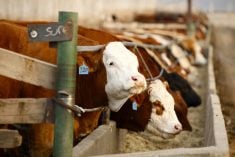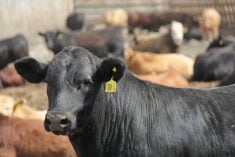Western Canadian feeder cattle prices experienced a soft tone this past week on very light volumes.
It’s that time of year where producers market the “stragglers,” or late bloomers, that were not up to standard earlier in spring. Therefore, the market was difficult to define but the overall sentiment felt malleable with various-quality cattle on offer. Shorter-keep cattle held value, with feedlots jumping on the opportunity of a healthy quick margin. A group of mixed steers averaging around 1,000 pounds sold for $232 in central Alberta.
Rising barley prices continue to pressure heavier calves and yearlings. Many feedlot operators were hesitant to step forward because they feel the drier conditions will cause larger volumes and higher-quality cattle to come onto the market over the next month. Medium-frame, medium-flesh mixed steers averaging just under 650 lbs. sold for $298 in central Alberta. Similarly, a small string of mixed heifers weighing just over 600 lbs. were quoted at $297 in the Edmonton region. Saskatchewan and Manitoba markets were rather quiet with many barns closed or selling minimal numbers.
Read Also

U.S. grains: Soy futures post biggest monthly gain in nearly five years on China trade optimism
U.S. soybean futures climbed to a 15-month high and posted their biggest monthly gain in nearly five years on Friday following a rally fueled by the prospect of revived exports to China.
Alberta packers were buying fed cattle in the range of $200-$201, down from the highs of $204 seven days earlier. Feedlot pen closeout breakevens are in the hovering in the range $191-$193, so the feeder market has some breathing room moving forward.
On the flip side, hay and forage prices have jumped sharply over the past month given the adverse dry conditions in Alberta and western Saskatchewan. Cow-calf pairs remain under pressure in these regions and auction barns report an increase in slaughter cows. Similarly, Alberta feedlot operators will experience higher straw prices this fall. The potential for the barley market to experience further upside could quickly erode the margin cushion. The market and overall environment is developing into drought-like conditions, which have also contributed to weaker emotional bias in the short term.
— Jerry Klassen is a commodity market analyst in Winnipeg and maintains an interest in the family feedlot in southern Alberta. He writes an in-depth biweekly commentary, Canadian Feedlot and Cattle Market Analysis, for feedlot operators in Canada. He can be reached by email at [email protected] for questions or comments.












